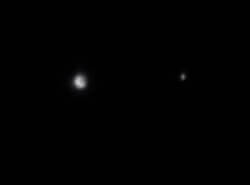NASA took advantage of the last opportunity to observe the Earth-Moon system during an eclipse from the planet closest to the Sun. In early 2015, the Messenger spacecraft will crash before it runs out of fuel

NASA published a video showing in time jumps the white eclipse that occurred on October 8 and was viewed from the half of the Earth that was then in darkness (and this time it did not include Israel, which was caught by the eclipse in the middle of the day).
The only difference between this video and other videos of the eclipse is that these images were not taken from Earth at all but from the planet closest to the Sun - Mercury.
The illustration in the video consists of 31 images taken two minutes apart by the Messenger spacecraft between 05:18 and 06:18 Eastern Time (13:18-12:18 Israel time), on October 8, 2014.
"From the planet Mercury, the Earth and the Moon are usually seen as two bright stars," says Harry Nair, a planetary scientist from the Johns Hopkins University Applied Physics Laboratory that developed and operates the MESSENGER mission for NASA.
"During the white eclipse, the moon disappears from view of the planet Mercury as it crosses the Earth's shadow as seen in the video."
According to Nair, the images were taken at 2x magnification and 25x the moonlight to increase visibility. The image was taken with the Messenger spacecraft's narrow-angle camera. The Earth and the Moon were distant 0.713 astronomical units (which is 106.6 million km) from the planet Mercury, from which the pictures were taken.
This was the second and last white eclipse of 2014. The next eclipse will occur on April 4, 2015, but by then Messenger will no longer be around to view it.
MESSENGER was launched on August 3, 2004 and began orbiting Mercury on March 18, 2011. It is now nearing the end of its mission and operational life but will still be observing for several months to learn more about the innermost planet in the Solar System before it makes its final pass and will crash into the face of Mercury in March 2015.
Video: NASA, Johns Hopkins University Applied Physics Laboratory, Carnegie Institution of Washington
